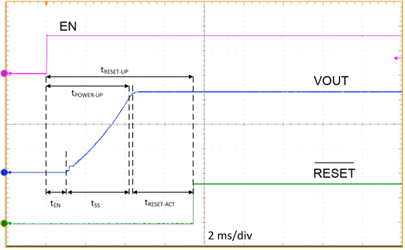SNVSAA7B December 2015 – July 2021 LM53625-Q1 , LM53635-Q1
PRODUCTION DATA
- 1 Features
- 2 Applications
- 3 Description
- 4 Revision History
- 5 Device Comparison
- 6 Pin Configuration and Functions
- 7 Specifications
- 8 Detailed Description
-
9 Application and Implementation
- 9.1 Application Information
- 9.2
Typical Applications
- 9.2.1 General Application
- 9.2.2 Fixed 5-V Output for USB-Type Applications
- 9.2.3 Fixed 3.3-V Output
- 9.2.4 Adjustable Output
- 9.3 What to Do and What Not to Do
- 10Power Supply Recommendations
- 11Layout
- 12Device and Documentation Support
- 13Mechanical, Packaging, and Orderable Information
8.3.2 Enable and Start-Up
Start-up and shutdown of the LM53625/35-Q1 are controlled by the EN input. Applying a voltage of ≥ 2 V activates the device, while a voltage of ≤ 0.8 V is required to shut it down. The EN input may also be connected directly to the input voltage supply. This input must not be left floating. The LM53625/35-Q1 utilizes a reference-based soft start that prevents output voltage overshoots and large inrush currents as the regulator is starting up. A typical start-up waveform is shown in Figure 8-4 along with timing definitions.
The waveforms shown in Figure 8-4 indicate the sequence and timing between the enable input and the output voltage and RESET. From the figure we can define several different start-up times depending on what is relevant to the application. Table 8-1 lists some definitions and typical values for the timings.
 Figure 8-4 Typical Start-up Waveform
Figure 8-4 Typical Start-up Waveform| PARAMETER | DEFINITION | VALUE | UNIT | |
|---|---|---|---|---|
| tRESET-READY | Total start-up sequence time | Time from EN to RESET released | 7.5 | ms |
| tPOWER-UP | Start-up time | Time from EN to 90% of VOUT | 4 | ms |
| tSS | Soft-start time | Rise time of VOUT from 10% to 90% | 3.2 | ms |
| tEN | Delay time | Time from EN to start of VOUT rising | 1 | ms |
| tRESET-ACT | RESET time | Time from output voltage within 94% and RESET released | 3 | ms |